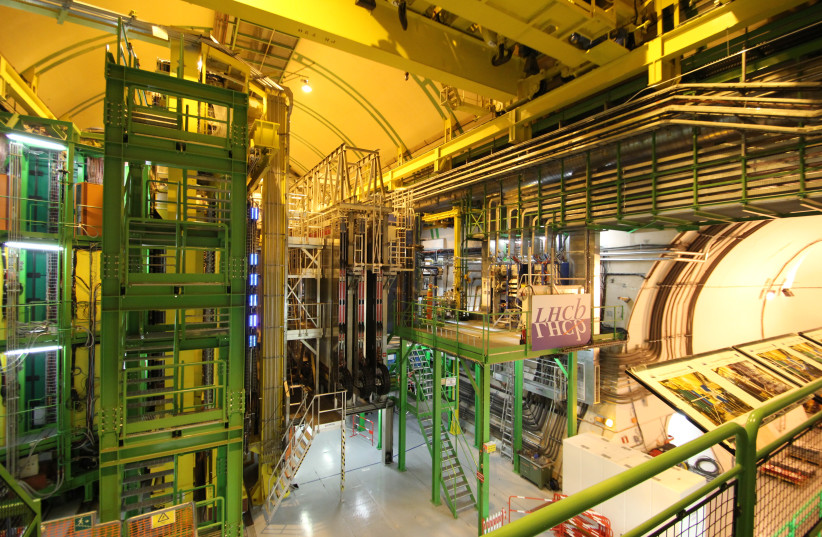New data analyzed by the Large Hadron Collider beauty (LHCb) experiment at CERN have found that previous data indicating a violation of the Standard Model of particle physics was flawed, with the new data matching up with the Standard Model, CERN announced on Tuesday.
In March 2021, physicists from the Universities of Cambridge, Bristol, and Imperial College London taking part in the LHCb experiment at CERN published an analysis that found evidence that "beauty quarks," a type of fundamental particle, do not decay in the way they should following the Standard Model.
Beauty quarks, particles similar to but heavier than electrons, interact with all forces in the same way, so they should decay into muons and electrons at the same rate.
However, the data collected by the LHCb seemed to show that these quarks are decaying into muons less often than they decay into electrons, which should only be possible if unknown particles are interfering and making them more likely to decay into electrons.
Even at the time, the University of Cambridge noted that the data was not strong enough to make any definitive statements as it was three standard deviations from the Standard Model, meaning there is a 1 in 1,000 chance that the measurement is a statistical coincidence.

The gold standard of particle physics is five standard deviations, also known as five sigma, meaning there is about a 1 in 3.5 million chance that the measurement is a statistical coincidence.
The new analysis by the LHCb, which has been conducted over the past five years, is more comprehensive than the data published last year. For the first time, it considers the decay modes of two different B-mesons - composite particles that contain beauty quarks - simultaneously and provides better control of the background processes that can mimic the decay of these mesons to electrons.
LHCb spokesperson Chris Parkes explained to Nature that one of the issues that caused the apparent discrepancies in the earlier data was that some particles were misidentified as electrons.
"The latest LHCb findings take nothing away from our mission to push the boundary of our knowledge further, and the search for anomalies, guided by experimental hints, goes on!”
Theoretical physicist Michelangelo Mangano of CERN
“Earlier LHCb indications of anomalies concerning lepton flavor universality triggered excitement,” said theoretical physicist Michelangelo Mangano of CERN in a press release. “That such anomalies could potentially have been real shows just how much remains unknown since theoretical interpretations exposed a myriad of unanticipated possible phenomena. The latest LHCb findings take nothing away from our mission to push the boundary of our knowledge further, and the search for anomalies, guided by experimental hints, goes on!”
Other findings still indicate possible issues with Standard Model
While the LHCb's earlier discrepancy has now been corrected, there are a number of other recent findings in other areas of physics which may poke holes in the Standard Model.
The Standard Model is a highly precise system used to understand physics and each part of that system interacts. If even one predicted measurement is slightly off from the real measurement, it could set the entire model off balance.
In April, physicists found that an elementary particle called a W boson seems to be about 0.1% heavier than it was predicted to be.
W bosons are fundamental particles that are responsible for the weak force, a fundamental force that can change the makeup of particles and is responsible for the processes that fuel the sun and cause particles to decay.
Other measurements conducted of the W boson have recorded a discrepancy between the measured weight and the weight expected by the Standard Model as well, but some of those measurements have been a lot closer to the Standard Model.
In June, an anomaly first observed in neutrino experiments in the 1990s was reaffirmed by a new experiment that possibly indicated a new, unconfirmed elementary particle or the need for a new interpretation of the Standard Model.
Neutrinos are the most abundant fundamental particles that have mass in the universe and have been detected from many sources, including the sun and cosmic-ray interactions. And they are among the least understood particles in the standard model of particle physics.
Neutrinos come in three "flavors" – electron, muon and tau – and oscillate between these flavors as they travel. However, in the 90s, scientists detected a gap in the timing between the oscillations at the Soviet-American Gallium Experiment (SAGE) in which the Los Alamos National Laboratory in New Mexico took part.
The newest instance of the anomaly was observed at the Baksan Experiment on Sterile Transitions (BEST) in Russia's Caucasus Mountains, where 26 irradiated disks of chromium 51 were used to irradiate an inner and outer tank of gallium, a soft, silvery metal used to detect neutrinos. The neutrinos hitting the gallium produce germanium 71, which scientists can then use to determine the number of direct collisions with neutrinos while in their electron flavor.
In the latest experiment, the measured rate of germanium 71 production was 20%-24% lower than expected based on theoretical modeling. The gap could be explained by the existence of sterile neutrinos - a possible fourth flavor of neutrino - which could be an important part of dark matter, although this requires further research.
